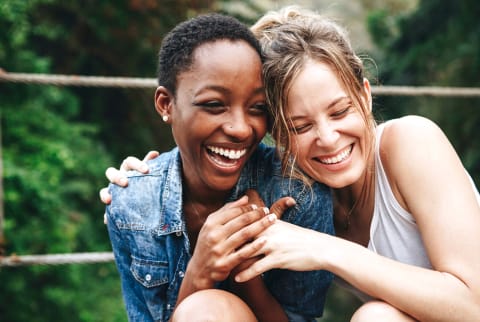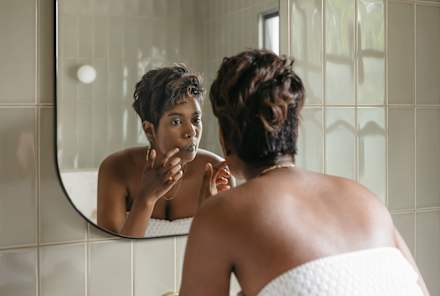Advertisement
The One Thing That Turns Good Friends Into Great Friends, From A Psychologist


According to “risk regulation theory” developed by Sandra Murray, a professor of psychology at the University of Buffalo, “confidence in a partner’s positive regard and caring allows people to risk seeking dependence and connectedness.”
In other words, to invest in a relationship, we need proof we won’t be rejected when doing so. Similarly, if we want people to invest in us, we need to make them feel safe, too. And we grant this security when we show affection. We impart that we love, value, and accept someone, so they can feel safe to take the risks of intimacy with us.
Affection makes our friends secure
To make and keep friends, risk regulation theory suggests that we don’t just need to be more secure. We need to make others secure. We need to become attachment sanctuaries, terrains of safety, and we can do this through showing affection.
Making others feel secure is not just a selfless act for our friends’ benefit; it’s in our best interest. Secure people, we’ve learned, are better friends—they are more vulnerable and authentic and take more initiative. When we make our friends know they are loved and accepted, they let their guard down and melt into a secure pro-relationship mode.
They feel comfortable initiating with us, checking in with us, affirming us, being vulnerable with us. They are invested in us. We bring out the best in them, and they bring out the best in us, in an upward spiral that brings out the best in friendship.
Risk regulation theory reveals just how harmful our culture of flakiness is. When we flake on someone last minute, we make them more insecure as we signal that we don’t value them—the opposite of what makes people feel comfortable investing in us. Instead of putting them in pro-relationship mode, we swing them into self-protection mode, and they stop reaching out to us.
Of course, when we flake, we don’t always mean to convey that we don’t like a person, but regardless of our intentions, the impact is all the same. I’ve been guilty of this myself. A friend of a friend invited me to her birthday, and it was later on in the evening and cold out. I had RSVPed yes, but as the hour drew nearer, I didn’t want to venture out. This friend never invited me out again, and she even told our mutual friend how hurt she was that I flaked and that she worried I didn’t like her.
What should we do instead? How can we use affection to make people feel secure enough to invest in us? If we meet a potential friend at a happy hour, instead of checking our texts during the conversation, we can greet them warmly and stay engaged. If we want our new friend to invite us for pizza, when they text to ask how we’re doing, instead of saying “Everything’s fine,” we can say, “It’s so good to hear from you! There’s so much I’ve wanted to tell you about.” If we want our friends to keep us abreast of their lives, when they tell us they received an award, instead of saying “That’s cool,” we say, “I’m so proud of you! There’s no one I know who deserves this more!” Although when we crave connection we tend to focus on our needs, when we stop thinking about whether we belong and shift to making others feel like they belong, we’ll inevitably belong too.
Expecting others to repeatedly make themselves vulnerable and reach out to us while we hide behind our walls—not showing any affection or openly receiving theirs—is expecting them to abandon their healthy mechanisms of self-protection, while failing to make them feel safe to do so.
Take Gabby and Rachel (two women I spoke with for my book Platonic), whose friendship aligns with the tenets of risk regulation theory. According to Gabby, “This friendship has helped me be more open to connecting with other people. It’s helped me realize my self-worth. I know that I am worthy of love. Having that has made me braver. If I didn’t have this friendship, I’d be much warier of going out and trying to connect with people, questioning whether I’m good enough. It’s given me confidence.” Because Rachel has made her feel secure, she feels comfortable investing not just in Rachel but in all her other friendships.
One of the important ways Rachel and Gabby show affection for each other is by showing enthusiasm for each other’s good news. When Gabby told Rachel that she was considering having a baby on her own, Rachel was ecstatic: “If you decide you want to go through this, you should know your future baby already has an auntie who loves them a ton. They’ve got family. And you have someone who’s going to Lamaze classes with you. I’m so excited for you, and I will be there!”
Research suggests that when Rachel responded with so much excitement at Gabby’s news, she further strengthened their friendship. A study called “I Like that You Bear My Pain, But I Love that You Feel My Joy1” found that we are more satisfied in our close relationships when other people are happy for our joy. In fact, this responsiveness more greatly predicted the quality of the relationship than how others responded to our suffering.
Another study involved a person going into the lab and sharing one of the best events that happened to them in the last few years with a “stranger” who was secretly working for the researcher. In one condition, the stranger responded enthusiastically (“Wow! That’s great”), and in another, the stranger neutrally asked a list of questions about the event, like “What makes your event so positive for you?” Afterward, participants reported feeling more closeness and liking for the responsive partner.
Lastly, as proof of risk regulation theory, a study found that in an interview, when the interviewer responded positively to something the interviewee expressed, the interviewee was more likely to return the money they were “accidentally overpaid” for their interview participation. When we show affection to people, they invest right back.
How to show affection to friends
Risk regulation theory showed us that making friends is about making people feel safe, whether that means giving them more affection or learning how to better receive theirs.
It also implicates us in the success of our friendships. Often, when our friendships are shallow, we blame our friends. “They’re not my people,” we might tell ourselves. That may be true. Sometimes people just don’t get along, but risk regulation theory suggests that if we want better friendships, it’s useful to turn the microscope back on ourselves, to assess “Do I make people feel safe? Do I show them I love and value them? Do I convey that they matter?”
One woman I interviewed, Anne, was aware she had walls but complained that others weren’t trying hard enough to climb them. But what Anne didn’t realize was that others have walls too; in fact, it’s healthy that they do.
Expecting others to repeatedly make themselves vulnerable and reach out to us while we hide behind our walls—not showing any affection or openly receiving theirs—is expecting them to abandon their healthy mechanisms of self-protection while failing to make them feel safe to do so. Instead of only asking why our friends don’t try more, we also must evaluate whether we make them feel safe to.
Here is a list of ways to show affection to a friend:
- Tell them how much they mean to you.
- When they reach out, tell them how happy you are to hear from them.
- Be excited at their good news.
- Compliment them.
- Praise their hard work.
- Greet them warmly.
- Let them know when they share something that’s meaningful to you.
- Tell them when you think of them in passing.
- Tell other people how great you think they are.
- Let them know when they impress you.
- Tell them they’ll succeed in reaching their dreams.
- Tell them when you think they have a great idea.
- Smile at them genuinely.
- Remind them you are grateful to know them.
Excerpted and adapted from PLATONIC by Marisa G. Franco, Ph.D., published by G.P. Putnam’s Sons, an imprint of the Penguin Publishing Group, a division of Penguin Random House, LLC. Copyright © 2022 by Bear One Holdings, LLC.











